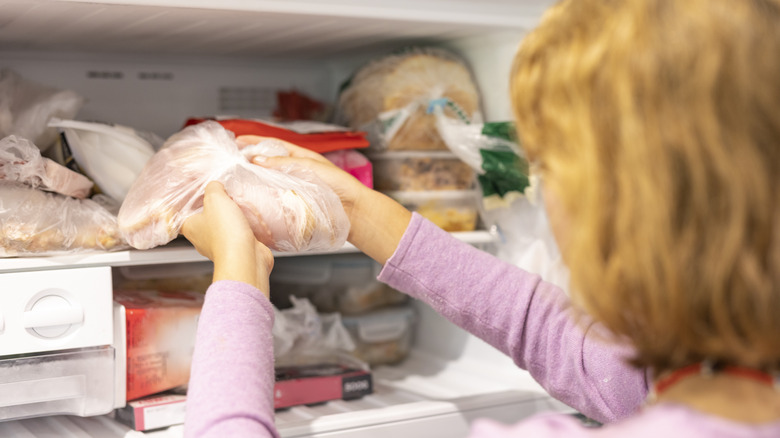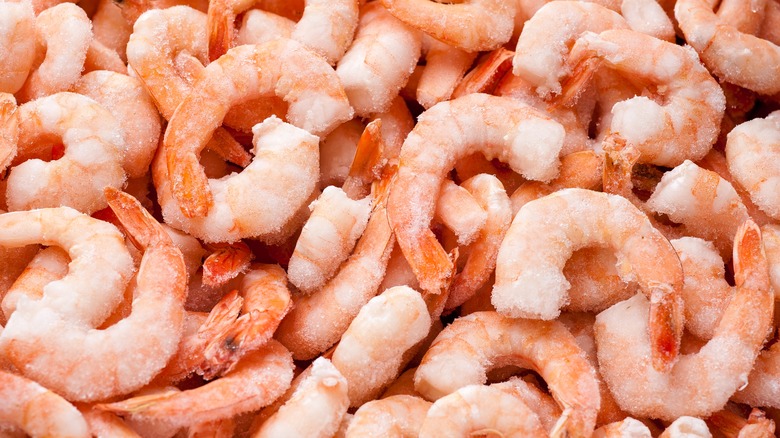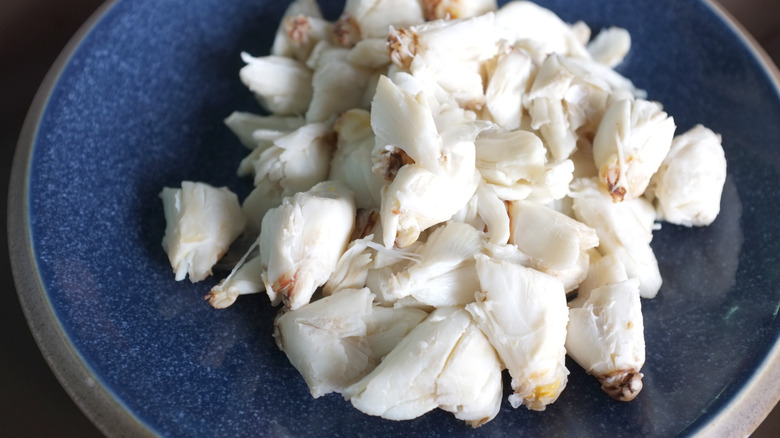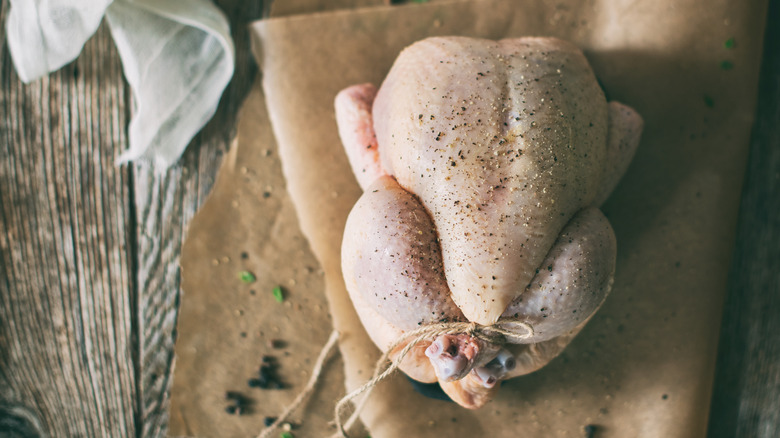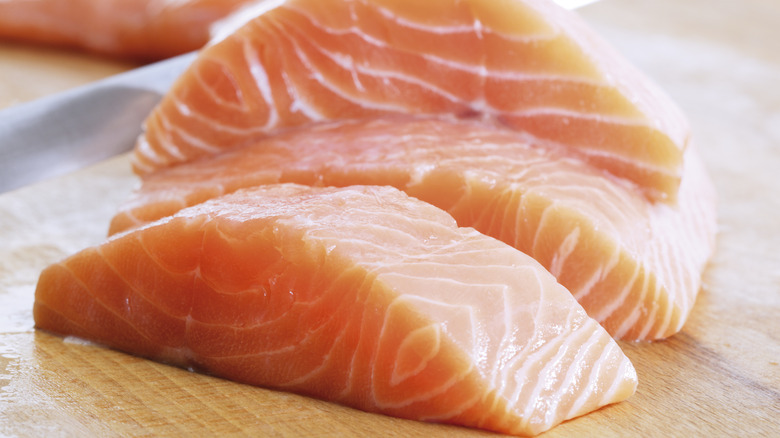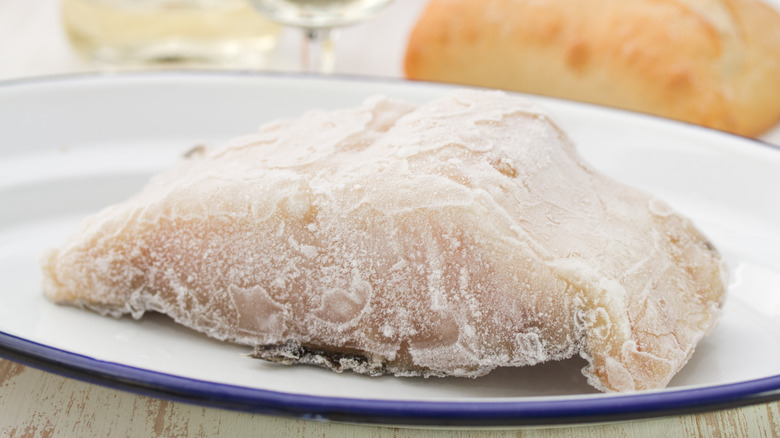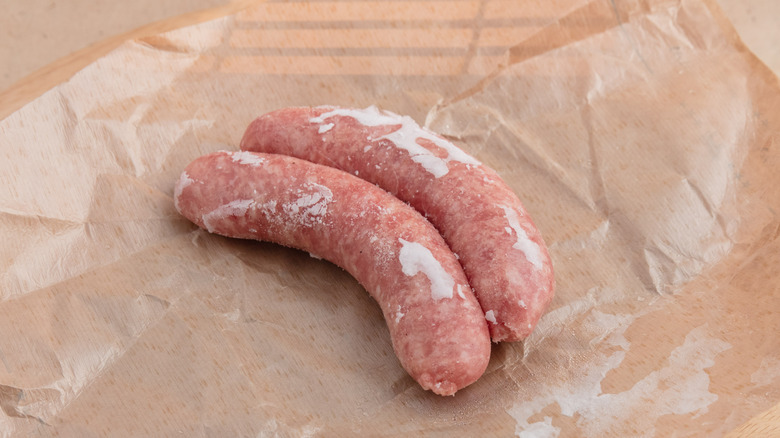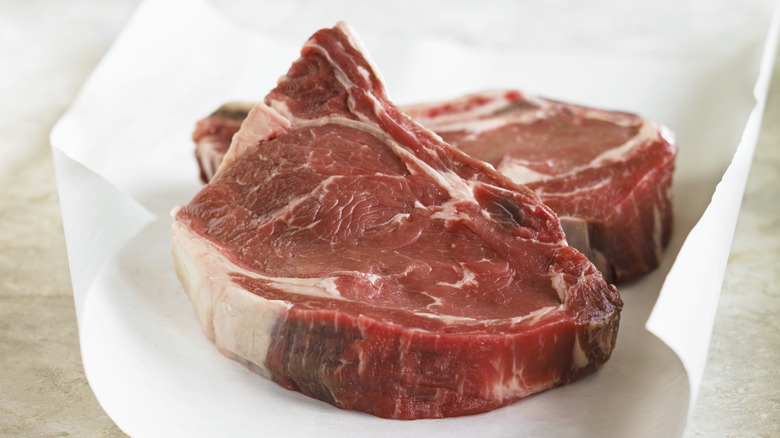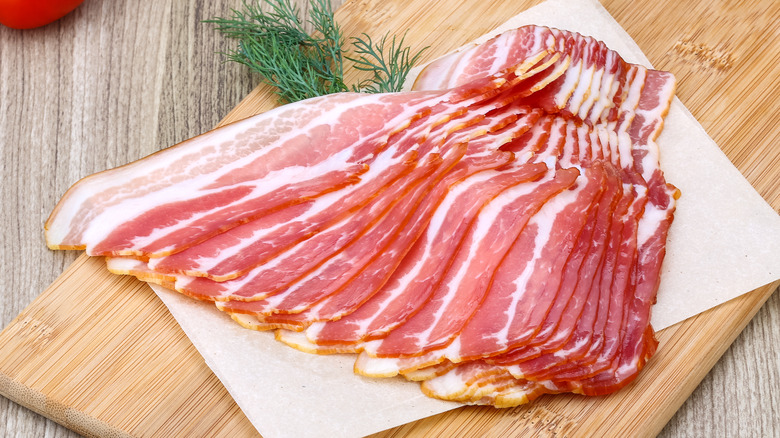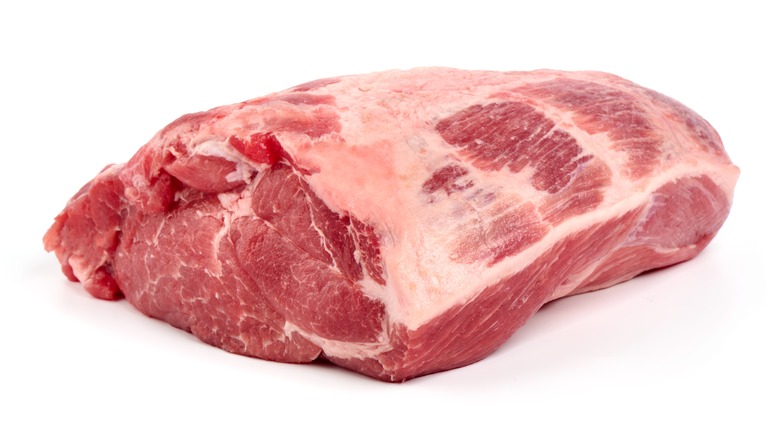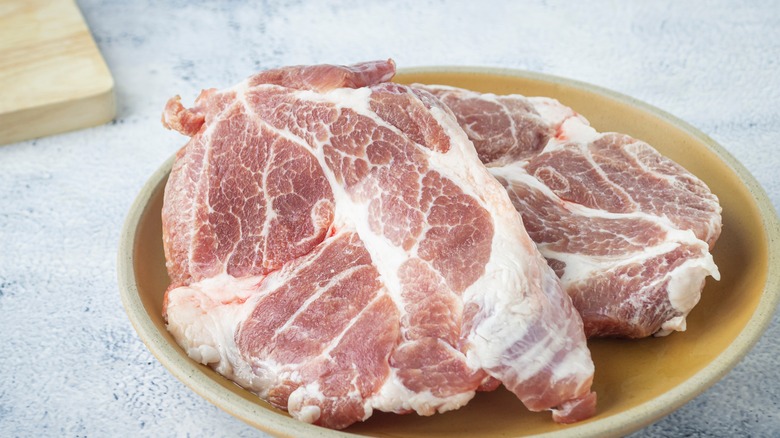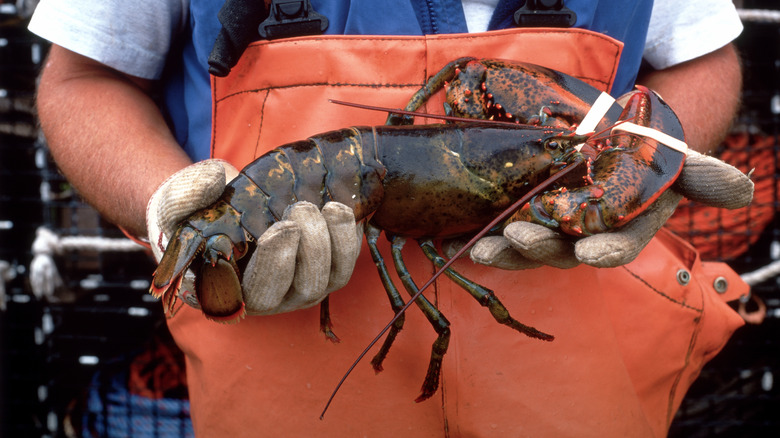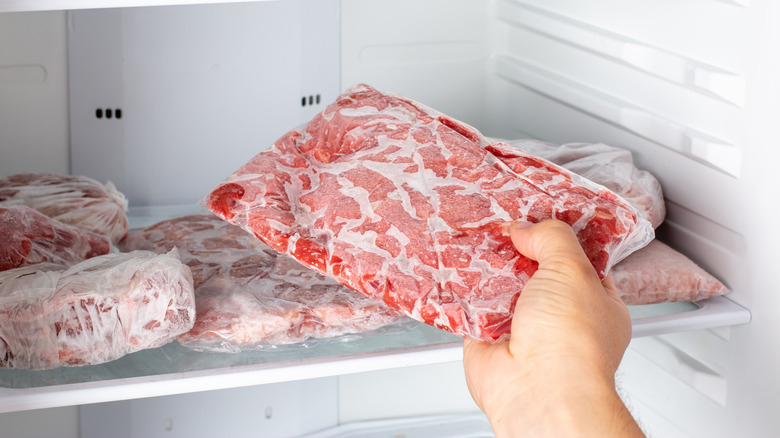The Best And Worst Meats And Seafoods To Put In The Freezer
Making the most of our freezers is always a great idea for preserving the freshness of food and extending its shelf life far beyond the capabilities of the fridge. Storing food in the freezer at a temperature of 0 degrees Fahrenheit or below is the best way to prevent bacterial growth. But, it isn't always a simple case of tossing any type of food item into the freezer and assuming it'll retain its quality indefinitely. And this is especially true when it comes to meats and seafood. Depending on the specific item, freezing may produce vastly different results when it comes to thawing and cooking.
While some items retain their taste and texture, others can suffer after a stint in the freezer, leading to disappointing meals and wasted food. Knowing which meats and seafoods freeze well, and which do not, can save you time and money in the kitchen. We're here to help. From shrimp and steak to fresh crab meat and ham, there are 13 meat or seafood items, you might commonly store in the freezer. Most of these options can be frozen in some capacity, but not all should be stored this way for extended periods, and there are some pretty major differences in recommended freezing times.
Best: Shrimp
Shrimp has to be one of the best types of seafood for freezing. Its firm texture and subtle taste hold up incredibly well during long periods in the freezer, so its always a convenient option to have on hand.
According to the U.S. Department of Health & Human Services, shrimp can be stored in the freezer for up to 18 months, which gives you plenty of time to come up with some delicious shrimp recipe ideas. Whilst there are no issues around the safety of eating shrimp that has been frozen for longer than this, sticking to this guideline will ensure the seafood retains its quality. This means a much more enjoyable eating experience for you!
Shrimp can be frozen either raw or pre-cooked. If the heads are intact, remove them before freezing, though its ok to leave the shells on as this can help to preserve freshness. If the shrimp is raw, give it a quick rinse and drain prior to freezing, too. Then, simply transfer the shrimp to a freezer bag or container, and pop it in the freezer. When you're ready to use the shrimp, you can thaw it out by placing it in the fridge for at least 12 hours, before preparing it as desired.
Worst: Fresh crab meat
We've covered the best, and now we're onto the meats and seafood that make less-than-ideal candidates for freezing. First up, we have crab meat, which whilst delicious when fresh, will not maintain quality when stored for extended periods in the freezer.
Fresh crab meat is particularly susceptible to losing its wonderful tender texture after freezing. Though it can retain its freshness for between two to four months, this can be difficult to achieve. It's best to freeze the delicate crab meat after incorporating it into a recipe, such as crab cakes. In this state, the meat has a little more protection against moisture loss. Keeping the crab meat inside the shell can also help with this.
If you have a whole, cooked crab, this will fare a lot better in the freezer. With the protection of the shell, the crab should keep well in the freezer for up to one year. As with all seafood, it's of course essential to store crab with care, to prevent the risk of foodborne illness. Always ensure that crab isn't left at room temperature for more than two hours, since this could lead to the growth of potentially harmful bacteria. If it has an off smell, dull color, or slimy texture, it has likely gone bad, and not worth the risk of eating!
Best: A whole chicken
It's common practice to pop a leftover chicken into the freezer, perhaps if you've bought a larger packet of breasts or thighs and want to store some of it for later. But, did you know that keeping a chicken whole is actually the best way to freeze it?
A raw, whole chicken will freeze exceptionally well and can maintain its quality for up to a year if stored properly. The key to freezing a whole chicken successfully lies in how it's packaged. If your chicken already comes in a vacuum-sealed package, it's good to go. Simply place it straight into the freezer. But, if the chicken isn't vacuum-sealed, it's a good idea to reinforce the plastic packaging with some extra layers, to prevent freezer burn. A great option is to wrap the packaged chicken tightly in aluminium foil before freezing.
Once you're ready to defrost the chicken, the best method is to place it back into the fridge, where it will take at least 24 hours to thaw, depending on the size of the bird. For a quicker thaw, you can use the cold water method: submerge the chicken in cold water, changing the water every 30 minutes. It is not recommended to thaw chicken at room temperature, or in the microwave, as at these conditions the meat can become a breeding ground for potentially harmful bacteria.
Worst: Salmon
Here's one that might surprise you. Despite being one of the most popular types of fish to cook up for dinner, salmon does not lend itself particularly well to freezing. Compared to leaner types of fish, like cod or halibut, which can be frozen for up to eight months, salmon should only be stored in the freezer for between two to three months if you want to enjoy it at its best.
If you do need to store salmon for an extended period of time, there are some techniques you can use to preserve its texture and flavor. If your salmon isn't already portioned into individual fillets, go ahead and slice it up. Then, take each piece of salmon and cover it tightly with plastic wrap. If you have a vacuum sealer, now is its time to shine. Place the wrapped salmon pieces into a freezer bag and suck out all of the air before storing. Alternatively, you can wrap the salmon with a layer of aluminium foil to offer it some extra protection against freezer burn.
Best: Cod
In the realm of fish, cod makes an excellent option for home freezing. Due to its lean nature, it retains its flavor and texture particularly well, and will remain fresh in the freezer for up to eight months. This is much longer than the recommended freezing time for salmon, and other fattier types of fish like mackerel and tuna, which will start to see a decline in quality after about three months.
To freeze cod effectively, using a vacuum sealer alongside plastic food bags will be the best method for preventing freezer burn. But, if you can't get your hands on one of these, you can try using the glazing method. This involves dipping each portion of fish into cold water, placing it onto a plate or baking sheet, and freezing until the layer of water has frozen. Then, this is repeated multiple times until you have a layer of ice approximately a quarter inch thick surrounding the fish. Glazing will help to lock moisture into the fish for optimum freshness.
Alternatively, cod can be wrapped tightly in plastic wrap before sealing into a freezer bag, though you will likely find the above methods more effective for preserving freshness. Other varieties of lean fish that can be frozen using the same methods, and for a similar timeframe, include flounder, haddock, halibut, and sole.
Worst: Sausages
Sausages are another family favorite, for whipping up everything from a breakfast casserole and to a smoky sausage pasta. But, regardless of whether they're raw or cooked, sausages are not really ideal for freezing.
If you need to freeze sausages or hot dogs, it's not recommended to store them for more than two months in the freezer, according the HHS. Keeping them there for any longer than this can result in the formation of ice crystals within the meat, which can have a detrimental effect on flavor and texture. Which the sausages would still be safe to consume, they'd likely be drier and tougher than their fresh counterparts.
When freezing sausages, you'll want to ensure that they don't stick together. Therefore, make sure to first wrap each sausage in greaseproof paper. You can then follow this with a generous layer of foil, to lock in moisture and keep air away from the meat. Pop your well-wrapped sausages into a freezer bag or container, squeezing out as much air as possible, then label them and freeze them until required for your next recipe. As with other types of meat, sausages should be defrosted slowly in the fridge to prevent the growth of food poisoning bacteria.
Best: Steak
Another type of meat that lends itself particularly well to freezing is steak. Whether it's a delicious steak cut of sirloin, rump, or ribeye, steak will keep for up to one year in the freezer, allowing you to enjoy a delicious steak dinner whenever you fancy. That said, three to four months is your window for best quality.
The best way to preserve the freshness and quality of a steak during freezing is to wrap it well. First, take each steak and wrap it tightly in plastic wrap. This will help to minimize the meat's contact with the air, to prevent freezer burn. Next, place the wrapped steaks into a freezer bag and seal everything up. It can be helpful to label the bag with the date and contents, to make sure you remember to use the meat within the recommended timeframe. Now, simply place the steaks into the freezer, ensuring they are stored flat and not folded over. This will make for easier defrosting later. When you're ready to cook the steaks, thaw them, still packaged, in the fridge for 24 hours. Alternatively, you can place the steak, still in its freezer bag, into a bowl of cold water for 30 minutes.
Worst: Bacon
A beloved breakfast staple, bacon is a favorite ingredient for many dishes, but sadly, it does not freeze well. This is due to the high fat content of the meat, which can result in an off flavor after freezing.
The U.S. Department of Health & Human Services recommends storing bacon in the freezer for no longer than one month. Keeping it for much longer than this is likely to result in a significant deterioration in flavor. Furthermore, since bacon slices usually come stacked on top of each other in the packet, they will stick together once frozen, which makes it near impossible to thaw individual pieces as needed.
If you do need to freeze bacon for a couple of weeks, you can use this handy tip to keep the slices separate from one another. First, separate the raw bacon strips. Next, roll up each strip, from the short end, into a spiral. Pop these on a baking sheet, ensuring they aren't touching, and place this in the freezer until the bacon is frozen — about half an hour. Finally, you can transfer the frozen bacon rolls to a freezer bag and seal it up, squeezing out any excess air. Now, when you need to grab a slice or two to defrost, you can do it with ease. One positive when it comes to bacon is the speed at which it thaws. Just place your packaged frozen bacon slices into a bowl of cold water and they should be ready to use within half an hour.
Best: Uncooked Ham
If you need to store an uncooked ham for an extended time period, you should have no problems keeping it fresh and flavorful in the freezer. This versatile meat comes in a few different forms, and each will have slightly different guidelines for freezing.
An uncooked and uncured ham will keep well for up to six months in the freezer, which gives you a generous timeframe to use it within. After this time period, it's quality may start to decline, so make sure to label the ham with the optimum use by date. If your uncured ham is already cooked, it can still be frozen, but it's recommended that you use this within four months. A cured but still uncooked ham can be frozen for a similar amount of time.
Ham can be frozen either whole or sliced. To prep a whole ham for freezing, wrap it tightly in plastic wrap or foil, then place it into a freezer bag. Make sure to squeeze out as much air as possible. If you're slicing or dicing the ham, split it into individual portions and package it up in the same way.
Worst: Cooked ham
Despite uncooked ham being suitable for up to six months of freezer storage, it's a different story for cooked ham. A whole or spiral cut ham, stored in its original packaging, will typically retain its quality for no longer than two months in the freezer, per HHS. For country ham, the recommended freezing time is even less, at just one month. For sliced cured hams like serrano, prosciutto, or parma ham, freezing is not recommended at all. This can result in meat that's dry, tough, and lacking in flavor.
If you absolutely must freeze cooked ham, store it for no longer than one month. Make sure to also wrap it well or vacuum-seal it for optimum preservation. Ideally, the best way to store cured hams like prosciutto or serrano is in the fridge, wrapped securely in plastic wrap, and kept away from other strong-smelling foods like cheese, which could affect the taste of the meat. Stored this way, the ham will keep well for up to three days. So, when it comes to cooked ham, it's best to buy just the amount you think you'll use within a few days, rather than stocking up for later.
Best: Pork chops
Like steaks, pork chops are also a great candidate for freezing, keeping well for four to 12 months before the quality declines. Freezing is a brilliant way to extend their shelf life, since in the fridge, they can only be stored for around four days.
When it comes to packing up the pork chops for freezing, leaving them in the original packaging is not recommended, since the trays that the chops tend to come in are not tightly wrapped enough to prevent freezer burn. For the best results, wrap each pork chop individually in freezer or butcher paper, securing them tightly with tape. After wrapping, place the pork chops in a heavy-duty freezer bag or airtight container, removing as much air as possible. For added protection, you could even use a vacuum sealer, which is especially effective at preserving the meat's quality over time.
When it's time to cook, thaw the pork chops slowly in the refrigerator, or using the cold water method if you're short on time. Ensure the meat is used within two days, post-thawing.
Worst: Live shellfish
For the final "don't do it" foodstuff on our list, freezing is not recommended at all, no matter the period of time for live shellfish. For foods such as lobsters, clams, or mussels, freezing is likely to cause you a whole lot of hassle when you come to use it.
Take lobster for example, where the meat is nestled without a tough outer shell. Well, if you freeze an uncooked lobster, its meat will expand in the cold temperatures of the freezer. This causes it to become compressed within the shell, with the meat sticking to the inside. Issues will ensue when you later come to defrost the lobster, since the meat will have a tendency to tear as is shrinks back down to its original size. Furthermore, the process of freezing and defrosting a lobster releases enzymes into its meat, which can give it an overly soft, undesirable texture.
If you want to freeze shellfish, your best bet is to cook it first. This will help to preserve the texture of that precious meat inside, and also give you the added peace of mind that any unwanted bacteria has been killed prior to freezing.
Best: Ground meat
Another easy-to-freeze food is ground meat, such as ground beef, pork, or turkey. This meat is easy to portion and super versatile, fitting into a range of delicious dishes from chili to casseroles. Stored correctly, ground meat will keep well in the freezer for up to four months.
To freeze ground meat, first divide the meat into portions that suit your typical cooking needs. Then, transfer each portion to a freezer bag. Next, take a rolling pin and use it to flatten the meat down inside the bag, so you end up with a layer approximately half an inch in thickness. This helps to remove air from the bag, protecting the meat from that pesky freezer burn. It also makes it convenient to store, since you can stack multiple bags up on top of each other, or side by side. Vacuum sealing the meat into the bag is also another great option if that's available to you.
When it's time to defrost the meat, it will also thaw much more quickly in this flattened form. Simply pop the frozen ground meat into the fridge, where it should thaw within about two hours.
